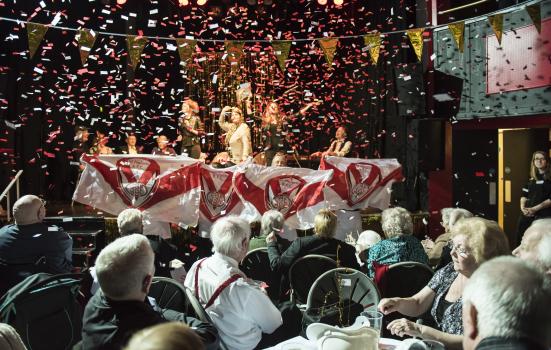A three-year evaluation has commended the Arts Council England programme as a source of learning for community arts, but raised concerns about its long-term sustainability.

Stephen King
More people from places with low levels of arts engagement are experiencing culture thanks to Arts Council England’s Creative People and Places (CPP) programme.
According to an overwhelmingly positive evaluation of its first three years, the community arts programme is starting to achieve its long-term goals of improving wellbeing and a sense of belonging, but researchers have raised concerns about its sustainability if and when its funding comes to an end.
The 21 CPP consortia, which have received a combined £37m over the past three years, have increased cultural participation by inviting people to choose, create and take part in art experiences where they live.
“The first three years of Creative People and Places has shown that involving local people in shaping arts programmes leads to some powerful results,” Holly Donagh, a consortium member for the CPP project in Barking & Dagenham, said.
“CPP’s participatory approach to culture and creativity is working and could be a model for the future of arts engagement, one that is more democratic and that challenges traditional models.”
Independent evaluation
The three-year independent evaluation of the programme, by research agency Ecorys, finds that it is now recognised as a source of good practice for the wider arts sector, and the report shares learning from the programme.
Parallel research by the Audience Agency calculates that the programme has engaged 1.45 million audience members in 3,099 activities so far. The researchers say the data “unanimously indicates” that more people from places of least engagement are experiencing the arts, with 91% of audience members and participants coming from neighbourhoods with low or medium levels of engagement in the arts.
The researchers also found CPP is changing perceptions of the arts and that participants are benefiting from greater empowerment, confidence and an increased sense of belonging in their communities, which has led to a greater sense of community cohesion in some areas.
Consortia working
Sharing lessons learned from CPP, the report indicates that good partnership working is key to successful community arts projects. It recommends “investing sufficient time, effort and resources” to nurture partnerships, as well as having “clarity around governance, roles and responsibilities”.
The researchers conclude that CPP consortia could benefit from working more closely with voluntary and amateur arts groups, and that commercial partnerships are a relatively unexplored opportunity for income generation. They also recommend more research be done on the minimum and ideal staffing structure for core CPP teams and the role of volunteers in increasing their capacity.
Aspirations for excellence
Assessing the “aspiration for excellence” in CPP projects, the researchers conclude that “excellence in art and community engagement is now understood by many Places to be linked” and that CPP has been influential in promoting this understanding in the wider arts sector.
CPP projects have trialled various methods of achieving and evaluating excellence in art and community engagement, the report notes, including methods based on Arts Council England’s (ACE’s) ‘quality metrics’ and “more fluid and instinctive” approaches.
The researchers conclude that a holistic view of quality is key and achieving excellence is about ensuring that the community, artists and management team “have time and space to openly reflect with each other and take on board feedback”.
Income and sustainability
The report raises concerns about whether CPPs will be able to continue to have a positive impact after their ACE funding comes to an end, and what this will mean for local arts infrastructures.
The CPP consortia are currently waiting to hear about their applications for up to £1m from a £5.3m funding pot for 2018-21, but ACE has made no guarantee of funding beyond that period.
Some CPP consortia – particularly the longest-running – have had success diversifying their income streams and increasing revenue for the arts in their areas. This has primarily been done by supporting individuals and community groups to access grants for their own arts projects, but also through crowdfunding for CPP projects, ticket sales and securing funding from other sources.
At least one CPP consortia is looking at becoming a National Portfolio Organisation, but the report warns many have much less developed sustainability and legacy plans, and the gap in relation to strength of plans appears to be widening.
“There has been common agreement among interviewees that the picture is mixed in terms of CPPs’ level of ambition and aspiration and it is still too early to say whether even examples that have been highlighted as excellent are going to continue beyond the period of Arts Council England funding,” the researchers warn.
They go on to note that it is more important for the communities to continue to engage with the arts, than for the consortia themselves to continue. CPPs must “build sufficient local capacity for the local community-led arts sector to continue to thrive,” they say.
Laura Dyer, Deputy Chief Executive Places & Engagement for Arts Council England welcomed the research saying it clearly demonstrates how successful the programme has been in reaching people who didn’t regularly engage in the arts before.
“It’s great to see the wellbeing, community pride, and social togetherness that arts and culture can promote, and such high levels of artistic engagement highlights the potential long-term benefits of this sustained approach,” she added.





Comments
LPottinger replied on Permalink
an alternative view
Stephen Pritchard replied on Permalink
(No subject)
Les Monaghan replied on Permalink
In Doncaster
Stephen Pritchard replied on Permalink
A fatally flawed report